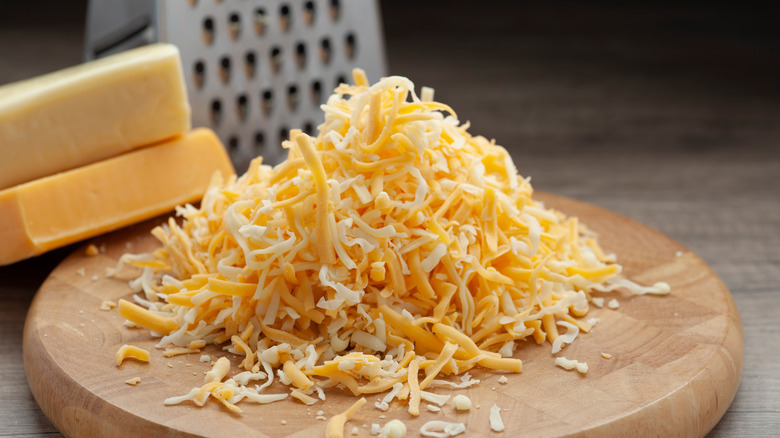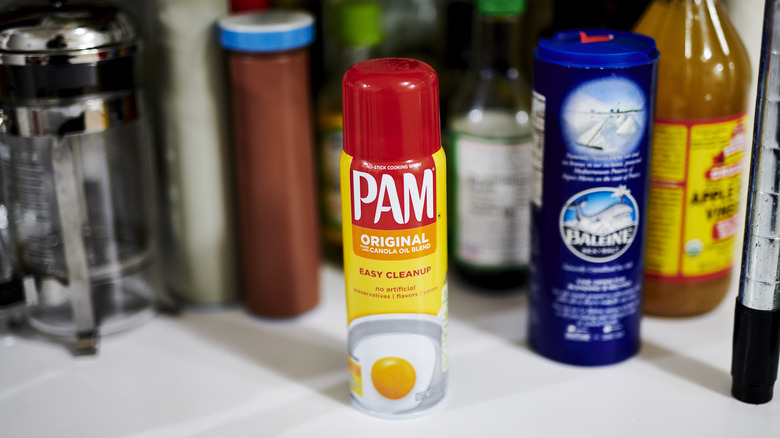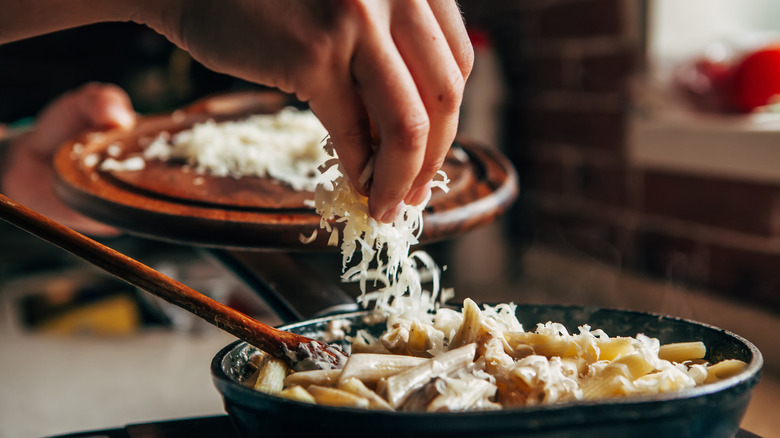The Cooking Spray Hack To Keep Cheese Graters From Getting Sticky
The cheese grater (or box grater) is a crucial piece of equipment in any cook's arsenal. It's reliable, too. And, with so many kitchen tools going digital and smart, it's nice to know "analog" implements are still around to keep our cooking hands-on. As written by The Cheese Professor, the cheese grater was invented in the 1540s and both François Boullier of France and England's Isaac Hunt to credit. Back then, cheese was not only in great supply but apparently so beloved that it necessitated such an innovation. But it's not without its issues: Even this simple tool can be confounding.
Case in point: How do you shred ingredients with ease and not contend with a clumpy mess? There are plenty of reasons why you'd hope your cheese-grating experience unfolds without a hitch, including pasta dishes like spaghetti with Parmesan cheese, breakfast-friendly foods like cheesy omelets, hearty chili with shredded cheddar, and single-dish classic casseroles. These comfort foods demand a lot of grating and fortunately, there's an easy way to keep the cooking going and the food flowing.
Spray your cheese grater with cooking spray
The problem with graters is that they create a large volume of shredded food, a.k.a. "a mess." This fills the interior of the box grater and gets all over the cutting board and counter while gumming up the holes of the grater in the heat of cooking. Reader's Digest Canada explains that using non-stick cooking spray helps with your grating duties and eases cleaning. Spice company McCormick seconds this notion, reporting that a grater sprayed will surrender sticky cheese clumps readily. Just be sure to wash it in cold water, not hot – Culinary Lore explains that hot water and a brush will help free up stubborn, clingy cheese bits during dishwashing.
Now that you know how to lubricate your cheese grater for maximum efficiency, you need to understand that there are different kinds of graters. If you're using a box grater, Good Housekeeping breaks down the types of shredding holes you're working with and the applications for which they're best suited. Large and medium holes are great for cheese and vegetables, while smaller holes yield fine shreds for hard cheeses, garlic, spices, and more. The latter is the hardest to clean, so spray your grater before use to make grating and cleaning (almost) as pleasant as eating.
Good Keeping also explains that you might encounter single-plane graters, rotary graters, and electronic graters, all of which operate the same basic way and will benefit from cooking spray before use.
Recipes and other uses for your cheese grater
With cheese sliding effortlessly off your grater, the only limit to what you can cook is your own imagination. An affordable block of mild, low moisture cheese can kickstart many recipes, including broccoli cheddar soup, baked potatoes, biscuits, enchiladas, nachos, and stuffed zucchini. Grating helps you distribute your cheese evenly (some may say, sensibly) and be economical with what you buy. But if you need a lot of shredded cheese in family-favorite dishes, like pizza, macaroni and cheese, or quiche, the humble grater is your comfort food comrade.
Even if you don't eat much cheese, you should keep a cheese grater handy for a few unexpected recipes. While its name divulges its primary use, the cheese grater will also come in handy for other applications, like prepping vegetables including peppers, carrots, cabbage, and potatoes, per Webstaurant Store, or to grate spices and chocolate for a perfectly flaky, irresistible pie crust. Meanwhile, Livestrong explains that the fine teeth of a box grater are ideal for shredding carrots for carrot cake.
But all of this is contingent upon one thing — the smooth operation of your cheese grater — and all it takes is a little nonstick spray for you to achieve grate-ness.


